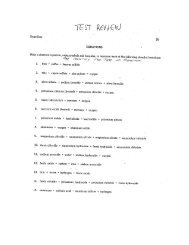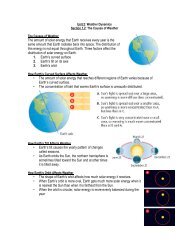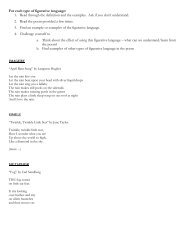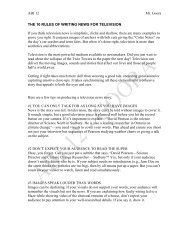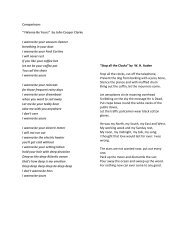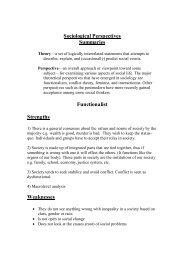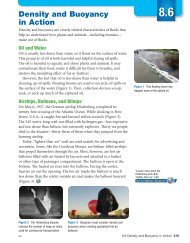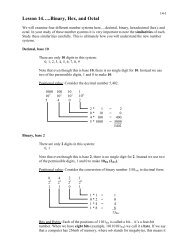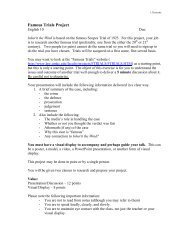assignment - HRSBSTAFF Home Page
assignment - HRSBSTAFF Home Page
assignment - HRSBSTAFF Home Page
You also want an ePaper? Increase the reach of your titles
YUMPU automatically turns print PDFs into web optimized ePapers that Google loves.
MATH STUDIES 11 – ASSIGNMENT<br />
SETS AND PROBABILITY<br />
1. One day the number of customers at three cafés, “Alan’s Diner” (A), “Sarah’s Snackbar” (S) and “Pete’s Eats” (P)<br />
was recorded and are given below.<br />
17 were customers of Pete’s Eats only<br />
27 were customers of Sarah’s Snackbar only<br />
15 were customers of Alan’s Diner only<br />
10 were customers of Pete’s Eats and Sarah’s Snackbar but not Alan’s Diner<br />
8 were customers of Pete’s Eats and Alan’s Diner but not Sarah’s Snackbar<br />
(a) Draw a Venn Diagram, using sets labelled A, S and P, that shows this information. (3)<br />
There were 48 customers of Pete’s Eats that day.<br />
(b) Calculate the number of people who were customers of all three cafés. (2)<br />
There were 50 customers of Sarah’s Snackbar that day.<br />
(c) Calculate the total number of people who were customers of Alan’s Diner. (3)<br />
(d) Write down the number of customers of Alan’s Diner that were also customers of Pete’s Eats. (1)<br />
(e) Find n[(S P) A′]. (2)<br />
(Total 11 marks)<br />
2. 100 students are asked what they had for breakfast on a particular morning. There were three choices: cereal (X),<br />
bread (Y) and fruit (Z). It is found that<br />
10 students had all three<br />
17 students had bread and fruit only<br />
15 students had cereal and fruit only<br />
12 students had cereal and bread only<br />
13 students had only bread<br />
8 students had only cereal<br />
9 students had only fruit<br />
(a) Represent this information on a Venn diagram. (4)<br />
(b) Find the number of students who had none of the three choices for breakfast. (2)<br />
(c) Write down the percentage of students who had fruit for breakfast. (2)<br />
(d) Describe in words what the students in the set X Y′ had for breakfast. (2)<br />
(e) Find the probability that a student had at least two of the three choices for breakfast. (2)<br />
(f) Two students are chosen at random. Find the probability that both students had all three choices for<br />
breakfast. (3)<br />
(Total 15 marks)<br />
3. Sharon and Lisa share a flat. Sharon cooks dinner three nights out of ten.<br />
If Sharon does not cook dinner, then Lisa does. If Sharon cooks dinner the probability that they have pasta is 0.75.<br />
If Lisa cooks dinner the probability that they have pasta is 0.12.<br />
(a) Complete a tree diagram to represent this information. (3)<br />
(b) Find the probability that Lisa cooks dinner and they do not have pasta. (2)<br />
(c) Find the probability that they do not have pasta. (3)<br />
(d) Given that they do not have pasta, find the probability that Lisa cooked dinner. (3)<br />
(Total 11 marks)<br />
4. The Venn diagram below represents the students studying Mathematics (A),<br />
Further Mathematics (B ) and Physics (C ) in a school.<br />
50 students study Mathematics<br />
38 study Physics<br />
20 study Mathematics and Physics but not Further Mathematics<br />
10 study Further Mathematics but not Physics<br />
12 study Further Mathematics and Physics<br />
6 study Physics but not Mathematics<br />
3 study none of these three subjects.<br />
(a) Copy and complete the Venn diagram on your answer paper. (3)<br />
(b) Write down the number of students who study Mathematics but not Further Mathematics. (1)<br />
(c) Write down the total number of students in the school. (1)<br />
(d) Write down n(B C). (2)<br />
(Total 7 marks)<br />
IB Questionbank Mathematical Studies 3rd edition 1
5. There are 49 mice in a pet shop.<br />
30 mice are white.<br />
27 mice are male.<br />
18 mice have short tails.<br />
8 mice are white and have short tails.<br />
11 mice are male and have short tails.<br />
7 mice are male but neither white nor short-tailed.<br />
5 mice have all three characteristics and<br />
2 have none.<br />
S<br />
M<br />
3<br />
5<br />
W<br />
U<br />
W represents white mice.<br />
M represents male mice.<br />
S represents short-tailed mice.<br />
(a) Copy and complete the diagram, using the information given in the question. (4)<br />
(b) Find (i) n(M W) (3)<br />
(ii) n(M′ S)<br />
Two mice are chosen without replacement.<br />
(c) Find P (both mice are short-tailed). (2)<br />
(Total 9 marks)<br />
6. When Geraldine travels to work she can travel either by car (C), bus (B) or train (T). She travels by car on one day<br />
in five. She uses the bus 50% of the time. The probabilities of her being late (L) when travelling by car, bus or train<br />
are 0.05, 0.12 and 0.08 respectively.<br />
(a) Create a tree diagram with all the probabilities, to represent this information. (5)<br />
(b) Find the probability that Geraldine travels by bus and is late. (1)<br />
(c) Find the probability that Geraldine is late. (3)<br />
(d) Find the probability that Geraldine travelled by train, given that she is late. (3)<br />
(Total 12 marks)<br />
7. Let U be the set of all positive integers from 1 to 21 inclusive.<br />
A, B and C are subsets of U such that:<br />
A contains all the positive integers that are factors of 21,<br />
B is the set of multiples of 7 contained in U,<br />
C is the set of odd numbers contained in U.<br />
(a) List all the members of set A. (2)<br />
(b) Write down all the members of (4)<br />
(i) A B;<br />
(ii) C' B.<br />
(c) Find the probability that a member chosen at random from A is also a member of (2)<br />
A B C.<br />
(Total 8 marks)<br />
1<br />
8. Amos travels to school either by car or by bicycle. The probability of being late for school is 10<br />
if he travels by<br />
1<br />
car and if he travels by bicycle. On any particular day he is equally likely to travel by car or by bicycle.<br />
5<br />
(a) Draw a probability tree diagram to illustrate this information. (4)<br />
(b)<br />
Find the probability that<br />
(i) Amos will travel by car and be late. (2)<br />
(ii) Amos will be late for school. (3)<br />
(c) Given that Amos is late for school, find the probability that he travelled by bicycle. (3)<br />
(Total 12 marks)<br />
9. Given a universal set U = {cars}, S = {sports cars}, G = {green sports cars}.<br />
(a) Draw a Venn diagram to illustrate this information. (3)<br />
(b) Shade the set S G′ on your diagram. (1)<br />
(c) Write in words the meaning of S G′. (2)<br />
(Total 6 marks)<br />
IB Questionbank Mathematical Studies 3rd edition 2



